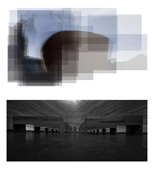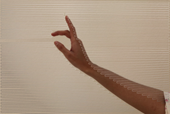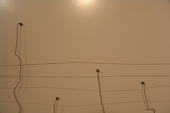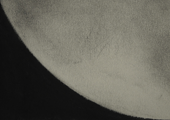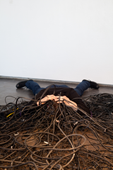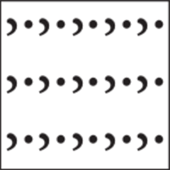Editorial
How do we expect a Journal for Artistic Research to look? What is the role and status of the design and layout of an exposition?
In JAR, all artists start with a white page onto which text and other media can be layered giving them control of the look of an exposition and not just its content. We have noted that, although initially intended simply as the expansion of artistic authorship, the fact that our contributors have to engage with design has had an interesting side effect. From a reader’s perspective the first encounter - before the first sentence has been read or the first video watched – has become very important. It is as if the point of delivery of a journal article has shifted forward, or as if this first encounter with the aesthetics of a page and the order in which material is arranged, anticipates what the exposition’s meaning (or ‘sense’) may be. Judgements about quality or artistic status seem to have become possible on the basis of a first glance.
While it is clear that such judgements cannot be substantiated without a more in-depth experience of an exposition, they nevertheless exist and matter. Conventional journals, as it were, protect their articles from such types of judgements by applying an identical style and layout across the whole journal. In JAR, on the other hand, contributions are exposed to a multilayered encounter where reading already takes place as a reader moves through the layers into what usually but not always is text. Talking about layers, however, does not mean that one moves from the periphery to the core; rather, meaning is distributed across those layers, each of which signifies something different, in a different constellation.
Thus, if a JAR exposition, for instance, uses a single column of linear text with little or no media support, we cannot jump to any form of conclusion about its, say, artistic quality or status. It is important to accept that expositions of practice as research can engage differently with the possibility of what may be called ‘surface reading’ – they can invite it or not, partially or completely, and if they invite it, they may play with it rather than have it represent the research in a condensed form. Thus, the look of an exposition does not represent the research.
At the same time, design and layout play an essential role in the overall expositional activity that is enacted between the various elements that make up an exposition. Artists are often particularly sensitive to the mediated qualities of knowledge, and this space between elements can be the site where knowledge is produced rather than simply represented. Hence, as part of the peer-review, we ask reviewers to judge whether the exposition design and navigation supports the epistemic perspective that is taken. This question is, in fact, not easy to answer, since the question is not only about functionality as sometimes understood; rather, it seeks to engage a reviewer with an assessment of the look of an exposition after he or she has engaged with the proposition and not as a vehicle for engagement. We are aware that much work still needs to be carried out in order to develop a language in which to communicate and negotiate the crucial role that layout and design can play within the exposition of practice as research.
It is difficult to say where an exposition of practice as research becomes apparent and starts to work in any particular case, not least because most communications of artistic research consist of a balanced mix of textual and non-textual elements, which may be deemed expositional. While such balanced choices seem possible, at JAR, we wonder if it is not also the result of a particular type of doctoral education that is averse to risk-taking and that follows ideas of transparency and representation appropriated from the sciences and the humanities rather than ideas of expositional engagement.. In order to pick up on this problematic, we also ask reviewers whether an exposition fulfils it’s potential assuming that potentials are more specific, cutting across standard distributions of ‘theory’ and ‘practice’. We hope reviewers will highlight cases where in particular the artistic side remains underdeveloped.
Looking back, we also have to apply some self-criticism regarding this point, since editorial guidance may at times have requested a submission to be further secured in academic conventions than may perhaps have been necessary. Lucy Cotter, who reviewed a submission for JAR2, makes the important observation in her comments that as a result of both review and editing ‘the artist’s voice is now at times drowned out by or buried under the academic’ in the particular contribution that she discusses. While others may disagree, it is important to remain sensitive to those possibilities.
It is great to see that the comments section really opens up a space for such thinking and questioning to which all registered Research Catalogue users (including authors) are invited to contribute either through the ‘comments’ link in the menu bar of each submission or the ‘add comments’ link below each abstract in the Research Catalogue. Disagreement is a distinct possibility when practice is exposed as research, since readers may approach what they see differently.
Expectations, I hasten to add, that require excessive use of media or highly original approaches to design and layout are also problematic, since they often suggest that artists need to demonstrate that they are artists rather than allowing a research practice to take its (expositional) course. This has, of course, to do with still existing habits of avant-gardism that notions of ‘research’ and ‘development’ unfortunately feed. It will be important, at some point, to critically disassociate the transformation of an artistic practice including its epistemic effects from an inscription into a historical trajectory that feeds off art’s ‘originality’.
Bearing all of this in mind, one has to be aware of the fact that the preparation of an exposition is an activity that requires a stance within complex relationships and that this stance cannot simply be seen as represented in its design. While design choices are relevant, they don’t necessarily communicate what an expositions means; rather, they suggest approaches to reading and ways into the material that help expose what otherwise may be overlooked. Because of this, all choices are open, no approach is in principle artistic or reflective and all depends on the way everything hangs together in an exposition.
Exposition design requires the development of new skill sets and sensitivity towards the ways in which meaning can be enacted. When ‘reading’ JAR, we suggest reflecting more upon the choices that are taken and how they might work on you as you approach what is presented than to compare them with ideas of artistic research that you might have. Because of these very specific choices, a Journal for Artistic Research cannot have a look.
Accordingly, all eight expositions of this third issue present unique approaches to artistic research and engagements with the design choices that the Research Catalogue offers. Miriam Ewers’ exposition, ‘Doha’, is based on interviews that she conducted with her students. The audio recordings are layered onto poetic images that are in themselves made up of photographic and computer graphic layers creating a tension between what is said, heard and seen. In Carolina Goradesky’s exposition ‘Innerground _ an Exploration of a Disused Mine Through the Memories of Former Miners’ a very particular sonic space is opened up between sound, memory and text into which one is guided downwards and across, as if exploring the shafts of a mine. Michael Kahr’s ‘Upper Styrian Big Band Folk: Exploring Local Identity and Authenticity in Jazz’ also deals with a very particular and local situation, while the exposition’s analysis and discussion of the music progresses in a linear fashion. Tero Nauha’s equally linear mode of writing, in his ‘Schizoanalysis as a Method in Artistic Research’, however, works of a sense of immersion and overflow, just like the metaphor of the sponge that he discusses. In Gert Germeraad’s ‘Rationality, Intuition and Emotion - Exploring an Artistic Process’ everything is precisely controlled and organized while his journal accesses a sphere below this, where form is in the process of taking shape, and nothing seems as fixed as on first sight. Simón Granell’s ‘Ten Diary Entries [2010-2012]’ introduce a very different way of using a diary questioning the possibility of originality that an artist might be able to access. In ‘Shift Happens’, Neil Mulholland reports on his educational research that responds to the present economic structures and conditions through a set of ‘shift/works’ that critically reposition both artists and educators. While, in ‘A Hinge: Field-testing the Relationship Between Photography and Architecture’, which discusses architecture and the way it may appear in photography, Marc Goodwin emphasizes the importance of atmosphere but also the critical angle photographic practice might take in relation to the conventional representation of architecture in photography.
Including our inaugural issue, there are now 28 expositions online that are published in JAR (next to many more expositions that are self-published on the Research Catalogue). While each exposition raises its own unique questions, relationships of practice and criticality may nevertheless be drawn. On this basis, we do get a sense that slowly but surely ‘artistic research’ can be sketched bottom-up as field where complex choices need to be taken and traced, suggesting the particular epistemic perspectives that artistic practice can create.
Michael Schwab
Editor-in-Chief

